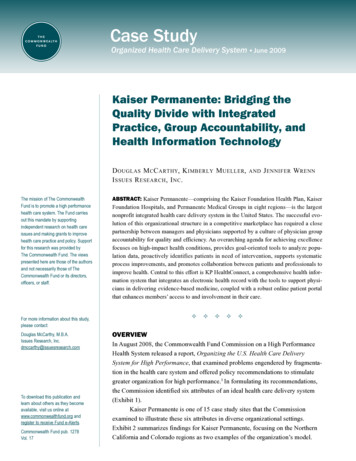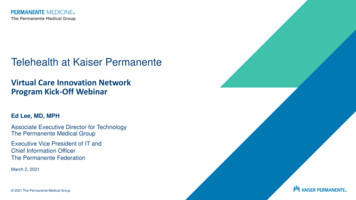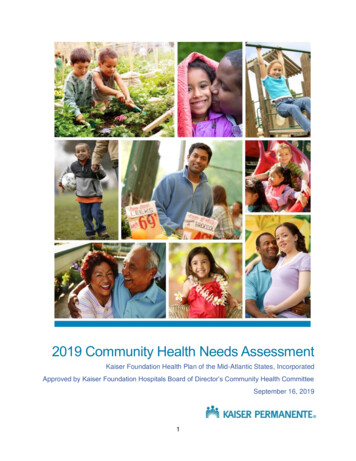
Transcription
Case StudyOrganized Health Care Delivery System June 2009Kaiser Permanente: Bridging theQuality Divide with IntegratedPractice, Group Accountability, andHealth Information TechnologyD ouglas M c C arthy, K imberly M ueller,I ssues R esearch , I nc .The mission of The CommonwealthFund is to promote a high performancehealth care system. The Fund carriesout this mandate by supportingindependent research on health careissues and making grants to improvehealth care practice and policy. Supportfor this research was provided byThe Commonwealth Fund. The viewspresented here are those of the authorsand not necessarily those of TheCommonwealth Fund or its directors,officers, or staff.To download this publication andlearn about others as they becomeavailable, visit us online atwww.commonwealthfund.org andregister to receive Fund e-Alerts.Commonwealth Fund pub. 1278Vol. 17J ennifer WrennABSTRACT: Kaiser Permanente—comprising the Kaiser Foundation Health Plan, KaiserFoundation Hospitals, and Permanente Medical Groups in eight regions—is the largestnonprofit integrated health care delivery system in the United States. The successful evolution of this organizational structure in a competitive marketplace has required a closepartnership between managers and physicians supported by a culture of physician groupaccountability for quality and efficiency. An overarching agenda for achieving excellencefocuses on high-impact health conditions, provides goal-oriented tools to analyze population data, proactively identifies patients in need of intervention, supports systematicprocess improvements, and promotes collaboration between patients and professionals toimprove health. Central to this effort is KP HealthConnect, a comprehensive health information system that integrates an electronic health record with the tools to support physicians in delivering evidence-based medicine, coupled with a robust online patient portalthat enhances members’ access to and involvement in their care. For more information about this study,please contact:Douglas McCarthy, M.B.A.Issues Research, Inc.dmccarthy@issuesresearch.comand OVERVIEWIn August 2008, the Commonwealth Fund Commission on a High PerformanceHealth System released a report, Organizing the U.S. Health Care DeliverySystem for High Performance, that examined problems engendered by fragmentation in the health care system and offered policy recommendations to stimulategreater organization for high performance.1 In formulating its recommendations,the Commission identified six attributes of an ideal health care delivery system(Exhibit 1).Kaiser Permanente is one of 15 case study sites that the Commissionexamined to illustrate these six attributes in diverse organizational settings.Exhibit 2 summarizes findings for Kaiser Permanente, focusing on the NorthernCalifornia and Colorado regions as two examples of the organization’s model.
2 T he C ommonwealth F undExhibit 1. Six Attributes of an Ideal Health Care Delivery System Information Continuity Patients’ clinically relevant information is available to all providers at the point ofcare and to patients through electronic health record systems. Care Coordination and Transitions Patient care is coordinated among multiple providers, and transitionsacross care settings are actively managed. System Accountability There is clear accountability for the total care of patients. (We have grouped thisattribute with care coordination, since one supports the other.) Peer Review and Teamwork for High-Value Care Providers (including nurses and other members of careteams) both within and across settings have accountability to each other, review each other’s work, andcollaborate to reliably deliver high-quality, high-value care. Continuous Innovation The system is continuously innovating and learning in order to improve the quality,value, and patient experiences of health care delivery. Easy Access to Appropriate Care Patients have easy access to appropriate care and information at allhours, there are multiple points of entry to the system, and providers are culturally competent and responsiveto patients’ needs.Information was gathered from Kaiser Permanente’sleaders, a site visit, and a review of supporting documents.2 The case study sites exhibited the six attributesin different ways and to varying degrees. All offeredideas and lessons that may be helpful to other organizations seeking to improve their capabilities for achieving higher levels of performance.3ORGANIZATIONAL BACKGROUNDSince its inception in 1945, Kaiser Permanente hasbecome the largest not-for-profit, integrated health caredelivery system in the United States, serving 8.6 million members in eight regions: Northern and SouthernCalifornia, Colorado, Georgia, Hawaii, the Mid-AtlanticStates, Ohio, and the Northwest (Exhibit 3). About threequarters of the members are in California, the organization’s birthplace. Its mission is to “provide affordable,high-quality health care services to improve the healthof our members and the communities we serve.”The Kaiser Permanente Medical Care Programcomprises three separate yet interdependent entities: Kaiser Foundation Health Plan (KFHP), KaiserFoundation Hospitals (KFH), and Permanente MedicalGroups in each region. These entities cooperate toorganize, finance, and deliver medical care undermutually exclusive contracts built on common vision,joint decision-making, and aligned incentives. KaiserPermanente is considered a “closed” group-model caresystem, since health plan members generally obtaincare from Permanente physicians—with exceptions,such as when using point-of-service plans or whenreferred for care outside the system.KFHP and KFH are not-for-profit corporations headquartered in Oakland, California, that sharea common board of directors. KFHP and its regionalsubsidiaries contract with individual, group, and public purchasers of coverage to finance a full range ofhealth care services for members. KFH arranges forinpatient care, extended care, and home health care forhealth plan members in owned or contracted facilities.It owns and operates 35 medical centers—hospitalswith multispecialty outpatient and ancillary services—in California, Oregon, and Hawaii. Outpatient medical office buildings, of which there are 431 across allregions, typically offer primary care, laboratory, radiology, and pharmacy services; some also offer behavioralhealth and other specialty care.The Permanente Medical Groups are multispecialty groups of physicians who accept a fixed payment(capitation) to provide medical care exclusively for
K aiser P ermanente : B ridgingtheQ uality D ivideKaiser health plan members in Kaiser facilities. Theyare organized as locally governed professional corporations or partnerships in each of the eight regions servedand are represented nationally by The PermanenteFederation. Working in cooperation with health planand facility managers, Permanente physicians takeresponsibility for clinical care, quality improvement,3resource management, and the design and operation ofthe care delivery system in each region.Kaiser Permanente’s workforce encompassesalmost 167,000 employees of KFHP and KFH and14,600 physicians in the Permanente Medical Groups.In 2008, Kaiser Foundation Health Plan and Hospitalsreported combined revenue of 40.3 billion and capitalExhibit 2. Case Study HighlightsOverview: Kaiser Permanente is the largest not-for-profit integrated delivery system in the U.S., serving 8.6 million health plan membersthrough exclusive contracts with physician-governed Permanente Medical Groups in eight regions (14,600 physicians nationwide). Facilitiesinclude 35 inpatient medical centers in three states and 431 outpatient medical office buildings located across all regions. Eight affiliatedresearch centers constitute one of the largest nonacademic research programs in the country.AttributeExamples from Kaiser Permanente Northern California and Colorado regionsInformationContinuityComprehensive health information management system integrating electronic health records with physician orderentry, decision support, population and patient-panel management tools, appointments, registration, and billingsystems.Member Web portal for online access to health information and educational resources, shared medical record, visithistory, appointment scheduling, prescription refills, lab test results, and secure mes saging with the care team.CareCoordinationand Transitions;SystemAccountability*Regional health plans are evaluated on how well they manage patients across the lifetime continuum of care (notjust a care episode), including ongoing linkage with an accountable primary care physi cian and team. There is “inreach” at every patient contact to check on and address outstanding preventive care needs.Stratified population and patient-panel manage ment: proactive primary care teams leverage ancillary staff andinformation systems to deliver proven preventive therapies and support patient self-care and lifestyle change. Careand case management and transitional care is provided for patients with uncontrolled disease or complex comorbidities.Primary care teams in Northern California include a behavioral medicine specialist (licensed clinical psychologist orclinical social worker) who co-manages patients with mental health conditions to support improved outcomes.Peer Review andTeamwork forHigh-Value CareIntegrated prepaid group-practice model inculcates a culture of group accountability for quality and efficiency supported by peer feedback and sharing of unblinded performance data within the group. Medical groups identify anddevelop internal clinical leaders.ContinuousInnovationPromotes organizational learning through in-house journal, annual innova tion awards, workshops, site visits, andlocal clinical champions. Care Management Institute convenes interregional expert teams to develop evidencebased guidelines, programs, and tools; identifies causes of variation and best practices for local adoption.Labor–management partnership defines common vision and commitment to shared decision-making involvingmanagers, physicians, and employees.21st Century Care Innovation Collaborative tests and spreads in novations to transform primary care using information technology. Kaiser hospitals are engaged in collaborative learning to attain the status of World Class Hospitalsusing rapid-change interventions.Garfield Innovation Center serves as a learning laboratory to support simulation, prototyping, and evaluation ofinnovations to improve health care delivery.Easy Access toMultiple entry options include call centers for primary care appointments and 24-hour nurse advice, after-hoursAppropriate Care urgent care, scheduled telephone visits, and electronic messaging with the care team. Group visits offer regularcontact with a multidisciplinary care team and peer support for patients with chronic illness.Culture-specific patient-care modules allow patients to communicate in native language with bilingual staff orientedto cultural norms. Institute for Culturally Competent Care designs programs and tools and guides Centers ofExcellence. Training programs develop bilingual staff and certify health care interpreters.*System accountability is grouped with care coordination and transitions since these attributes are closely related.
4 T he C ommonwealth F undspending of 2.9 billion. Spending on communitybenefit programs amounted to 1.2 billion for community health promotion, charity care and safety-netinstitutions, professional education, and research. Eightaffiliated research centers constitute one of the largestnonacademic research programs in the country.This case study draws primarily from the experience of the Northern California region, with supportingexamples from Colorado and other regions (Exhibit 4).Because the organization operates in a decentralizedfashion with regional autonomy to meet local needs,these examples may or may not be typical of the program as a whole.In the Northern California region, about 7,000Permanente physicians serve 3.2 million membersfrom the San Francisco Bay area east to Sacramentoand the Central Valley. In the Colorado region, established in 1969, about 480,000 members receive carefrom 800 Permanente physicians in the DenverBoulder area and from affiliated community physiciansin the Colorado Springs area. Market share for thetwo regions is about 44 percent and 16 percent in theirrespective market areas, composed predominantly ofcommercial coverage (87% and 85% respectively) andMedicare (11% and 13%).INFORMATION CONTINUITYKaiser Permanente has been using information technology for more than 40 years to improve clinical andadministrative functions.4 Its use of electronic healthrecords (EHRs) dates from the 1990s in some regions.5Building on this experience, and with the active participation of its physicians, Kaiser Permanente in 2003launched a 4 billion health information system calledKP HealthConnect that links its facilities nationwideand represents the largest civilian installation of EHRsin the United States. As of April 2008, the system wassuccessfully implemented in outpatient clinics in alleight Kaiser regions. Every Kaiser hospital has theessential components of the system and 25 had implemented all modules as of December 2008.6The EHR at the heart of KP HealthConnect(purchased from vendor Epic Systems Corp.) providesa longitudinal record of member encounters acrossclinical settings and includes laboratory, medication,and imaging data. HP HealthConnect also incorporates: electronic prescribing and test ordering (computerized physician-order entry) with standardorder sets to promote evidence-based care population and patient-panel management toolssuch as disease registries to track patients withchronic conditionsExhibit 3. Kaiser Permanente RegionsNote: Circles represent approximate geographic service areas.Source: Adapted from information on the Kaiser Permanente Web site.
K aiser P ermanente : B ridgingtheQ uality D ivide5Exhibit 4. Kaiser Permanente Service Areas:Northern California and Colorado RegionsSource: Kaiser Permanente. decision support tools such as medication-safetyalerts, preventive-care reminders, and onlineclinical guidelines electronic referrals that directly schedule patientappointments with specialty care physicians performance monitoring and reporting capabilities patient registration and billing functionsKP HealthConnect is designed to electronicallyconnect members to their health care team, to theirpersonal health information, and to relevant medical knowledge to promote integrated health care. Forexample, members can complete an online healthrisk assessment, receive customized feedback onbehavioral interventions, participate in health behaviorchange programs, and choose whether to send resultsto KP HealthConnect to facilitate communication withtheir physician.To more fully engage patients in their care,physicians and staff encourage them to sign-up forenhanced online services. As a result, more thanone-third of health plan members nationwide (andnearly one-half of members in Northern California)are using a Web portal called My Health Manager totrack selected medical information from the EHR,view a history of physician visits and preventive carereminders, schedule and cancel appointments, refillprescriptions, and send secure electronic messages totheir care team or pharmacist.7 Online laboratory testresults—the most popular online function—includelinks to a knowledge base of information on test resultsand related self-care strategies. A pilot project is testingthe capability for members (initially Kaiser employees) to transfer information securely from My HealthManager to Microsoft Corporation’s HealthVault personal health record application.8Physician leaders report that access to the EHRin the exam room is helping to promote compliancewith evidence-based guidelines and treatment protocols, eliminate duplicate tests, and enable physiciansto handle multiple complaints more efficiently withinone visit.9 A study in the Northwest region found thatpatient satisfaction with physician encounters increasedafter the introduction of the EHR in exam roomsthere.10 Early findings from ongoing hospital implementations suggest that the combination of computerized physician-order entry, medication bar-coding, andelectronic documentation tools is helping to reducemedication administration errors.Use of the EHR and online portal to supportcare management and new modes of patient encountersappears to be having positive effects on utilization ofservices and patient engagement. For example, threequarters or more of online users surveyed agreed thatthe portal enables them to manage their health care
6 T he C ommonwealth F undExhibit 5. Kaiser Permanente Hawaii:Distribution of Patient Contacts, 1999–2007Secure messaging*Scheduled telephone visitsOffice visitsContacts per 9920022001200220032004200520062007*Measurement for secure messaging began in 2005.Source: Kaiser Permanente.effectively and that it makes interacting with the healthcare team more convenient.11 Patients in the Northwestregion who used online services made 10 percent fewerprimary or urgent care visits than before they hadonline access (7 percent fewer visits compared with acontrol group of patients).12The Hawaii region experienced a 26 percentdecrease in the rate of physician visits followingimplementation of KP HealthConnect (Exhibit 5).Overall patient contacts increased by 8 percent dueprimarily to a large increase in scheduled telephonevisits. Urgent care and emergency department visitsincreased, although the increase accounted for onlyabout 5 percent of the decrease in office visits. Theauthors speculated that the EHR facilitated moreefficient care delivery and helped doctors resolveproblems over the telephone.13CARE COORDINATION AND TRANSITIONS:TOWARD GREATER ACCOUNTABILITY FORTOTAL CARE OF THE PATIENTHaving a broad spectrum of services available withinone organization and, in many cases, in one location,makes it easier to coordinate care for patients. KaiserPermanente’s integrated model of care focuses not onlyon the spectrum of medical care that a patient mayneed at any one time, but also on members’ interactionswith the organization across time and the continuum ofcare—clinic, hospital, home, hospice, or extended care.The Northern California region, for example,stresses “in-reach” to patients at every contact (not justduring primary care visits) to check on outstandingpreventive care needs and to schedule services suchas mammograms. Medical assistants receive feedbackreports that prompt them to follow-up with patientswhose preventive care needs were not addressed during a recent clinic visit. As a result of such in-reach andoutreach efforts, the plan’s breast cancer screening ratein 2007 was 79 percent among women (ages 40 to 69)with private coverage and 86 percent among Medicaremembers, as compared with national rates of 69 percent and 67 percent, respectively.Regions are evaluated on how well members arelinked or “bonded” to a primary care physician and an“accountable unit” (module or team of providers) thatis responsible for coordinating and ensuring continuityof care. This whole-person perspective may contributeto member loyalty: California members stay enrolledfor 14 years on average, compared with four years forcompetitors.Improving Population Health. The NorthernCalifornia region uses a population and patient-panelmanagement strategy to improve care and outcomes
K aiser P ermanente : B ridgingtheQ uality D ividefor patients who have—or who are at risk for developing—chronic diseases. This approach is built on thephilosophy that a strong primary care system offers themost efficient way to interact with most patients mostof the time, while recognizing that some patients needadditional support and specialty care to achieve thebest possible outcomes. Patients are stratified into threelevels of care:1. Primary care with self-care support for the65 percent to 80 percent of patients whoseconditions are generally responsive to lifestylechanges and medications.2. Assistive care management to address adherence problems, complex medication regimens,and comorbidities for the 20 percent to 30 percent of patients whose diseases are not undercontrol through care at level one.3. Intensive case management and specialtycare for the 1 percent to 5 percent of patientswith advanced disease and complex comorbidities or frailty.Level one emphasizes a proactive teamapproach that conserves physician time for face-toface encounters by enhancing the contributions ofancillary staff (medical assistants and also nurses andpharmacists in some locations) to conducting outreachto patients between visits. The team uses a populationdatabase and decision support tools built into the EHRto track patients with chronic conditions such as diabetes or heart disease, develop action plans to engagethem in self-care, ensure that they are taking appropriate medications, and remind them to get preventivecare and other tests when needed.Outreach to patients with chronic conditionstypically occurs as follows: The physician reservesa weekly appointment slot to meet with his or herstaff and review a computer-generated list of 10 to 20patients who are not achieving treatment goals. Thephysician indicates follow-up instructions for each7patient, such as increasing medication dosage or ordering a test. The medical assistant or nurse then contactsthe patient to relay the physician’s instructions, usingprepared scripts to ensure consistent communication.Contact is typically made by telephone but may occurby letter in some cases.At level two, care managers (specially trainednurses, clinical social workers, or pharmacists) supportthe primary care team to help patients gain control of achronic condition. Interventions may include providingself-care education, titrating medications according toprotocol, and making referrals to educational classes(e.g., for smoking cessation). The goal is to movepatients back to level one after an intervention periodof several months to a year. Successful transitionsrequire that primary care teams be prepared to followup with patients and prevent them from relapsing. Caremanagers may be part of the local primary care team ormay be centrally located at a medical center, dependingon local resources.An example of intensive case management(level three) is a cardiac rehabilitation program calledMultifit for patients with advanced heart disease, suchas those recovering from a heart attack or heart surgery.Nurse case managers provide telephonic educationand support for up to six months to help patients makelifestyle changes and reduce their risk of future cardiacevents. Aided by the EHR and a patient registry, theColorado region enhanced the program by adding a telephonic cardiac medication management service provided by clinical pharmacy specialists, with ongoingfollow-up until patients achieve treatment goals andcan be transferred to primary care for maintenance.14Results for patients participating in the Colorado program included the following: Cholesterol screening increased from 55 percent to 97 percent of patients, while cholesterolcontrol has almost tripled from 26 percent to 73percent of patients.15 The Colorado plan rankedfirst among health plans nationally in 2007 ona measure of cholesterol screening for patientswith cardiovascular conditions.16
8 T he C ommonwealth F und Relative risk of death declined by 89 percentamong those enrolled in the program within 90days of a cardiac event, and by 76 percent forthose with any contact with the program.17 Anestimated 260 major cardiac events and 135deaths have been avoided per year because ofthese improvements.18The Northern California region in 2004 initiated a program called PHASE—Prevent Heart Attacksand Strokes Everyday—to consistently deliver provenprevention therapies for controlling blood pressure,blood lipids, and blood glucose among a broadlydefined population of patients at risk for cardiovascular disease. Diabetics make up two-thirds of the targetpopulation, which also includes patients with coronaryartery disease, stroke, chronic kidney disease, peripheral arterial disease, and abdominal aortic aneurysm.Interventions include prescribing four drugs wheneverappropriate—aspirin, lipid-lowering medications, ACEinhibitors, and beta-blockers—and promoting fourlifestyle changes: tobacco cessation, physical activity,healthy eating, and weight management.Focusing on the entire spectrum of primary, secondary, and tertiary prevention for cardiac care management has resulted in the following improvements incare and outcomes in the Northern California region: The prevalence of adult smoking declinedfrom 12.2 percent to 9.2 percent of membersfrom 2002 to 2005, more than twice the rate ofimprovement in the California population as awhole (Exhibit 6). Blood pressure control more than doubled, from36 percent of patients with hypertension in 2001to 77 percent of 313,000 patients with the condition by the third quarter of 2008 (Exhibit 7).The plan ranked third-highest in the nation onthis measure in 2007, according to the NationalCommittee for Quality Assurance (NCQA). Appropriate receipt of target prescription medications increased from 41 percent to 53 percent of PHASE patients from 2004 to 2008.19Blood glucose control (hemoglobin A1c 9%)improved from 66 percent to 73 percent of diabetic patients, while cholesterol control (LDL-C 100) improved from 50 percent to 63 percentof all PHASE patients from 2005 to 2008. Hospitalization rates (age/sex adjusted) declinedby 30 percent for coronary heart disease, by 56percent for ST-elevated myocardial infarction(heart attack), and by 20 percent for strokesfrom 1998 to 2007.Exhibit 6. Kaiser Permanente Northern California:Adult Smoking Prevalence in 2002 and 2005Percent of adult population who currently smoke25200223.0200520.92016.41515.2Healthy People 2010Goal 12%12.29.21050United StatesSource: Kaiser Permanente.CaliforniaKaiser PermanenteNorthern California
K aiser P ermanente : B ridgingtheQ uality D ivide9Exhibit 7. Kaiser Permanente Northern California:Trend in Blood Pressure Control Rate: 2001–2008Percent of hypertensive patients with blood pressure under control ( 140/80)10080604036484353566160647571 72*5.014.777775754.133.7020077Q4 Q1 Q2 Q3 Q4 Q1 Q2 Q3 Q4 Q1 Q2 Q3 Q4 Q1 Q2 Q3 Q4 Q1 Q2 Q3 Q4 Q1 Q2 Q3 Q4 Q1 Q2 Q320012002200320042005200620072008*Measure definition changed in 2006 from population ages 46–85 to ages 18–85.Source: Kaiser Permanente. The heart disease mortality rate decreased by26 percent from 1995 to 2004. As of 2004,Northern California Kaiser Permanente members had a 30 percent lower chance of dyingfrom heart disease than other Californians(Exhibit 8).medicine specialist co-manages patients with identifiedmental health conditions such as depression or anxietydisorders, providing counseling (using proven modalities such as cognitive behavioral therapy or behavioralactivation) and problem-solving support individually orin group sessions. The patient’s primary care physicianis responsible for medication management. Patientswith severe mental health conditions or substance usedisorders are referred to psychiatric specialty care orchemical dependency treatment.Integrating Behavioral Health and Primary Care.Each primary care team in Northern Californiaincludes a behavioral medicine specialist, who is alicensed clinical psychologist or clinical social workertrained to work in primary care. The behavioralExhibit 8. Kaiser Permanente Northern California:Heart Disease Mortality 1995–2004Deaths due to heart disease per 100,000 100183183173171172167156188136Rest of California500182202Kaiser Permanente Northern California region1995199619971998199920002001*Age- and sex-adjusted to the 2004 Kaiser Permanente standard population.Source: Kaiser Permanente Northern California Division of Research.200220032004
10 T he C ommonwealth F undSince many patients have co-occurring mentaland physical conditions, colocation of behavioral medicine specialists in primary care allows a broad perspective that is superior to disease-specific approaches.It also improves access to mental health care, sincemany patients prefer to receive such services from theirprimary care team and may not visit mental health specialists even when referred.Through its participation in a study of a collaborative care model called IMPACT, the organizationlearned that outcomes could be enhanced by adoptinga more systematic approach to caring for patients withdepression. As a result, the region recently began usinga population database and a patient-completed questionnaire called the PHQ-9 to track patients’ progressand provide feedback so that the physician and behavioral medicine specialist can tailor treatment to achievesymptom-improvement goals.20 The region rankssecond among health plans nationally on a measure ofantidepressant medication management–acute phasetreatment, according to the NCQA.Improving Transitional Care. The Colorado regionoffers a telephonic care coordination program toimprove follow-up care for patients discharged froma hospital or skilled nursing facility. The programalso services patients who frequently visit the emergency department (ED) or are at risk of hospitalizationbecause of multiple chronic conditions.Care coordinators (specially trained nurses orsocial workers) contact discharged patients within 24hours to assess needs and stratify them to receive shortor longer-term services that may include verifyingmedications, developing self-care skills, coordinatingservices, and making referrals to community resources.Information on each patie
2 th e co M M o n W e a l t h fu n D Exhibit 1. Six Attributes of an Ideal Health Care Delivery System Information Continuity Patients' clinically relevant information is available to all providers at the point of care and to patients through electronic health record systems. Care Coordination and Transitions Patient care is coordinated among multiple providers, and transitions










